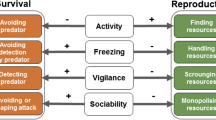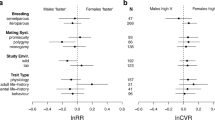Abstract
The pace-of-life syndrome hypothesis predicts that individual differences in behavior should integrate with morphological, physiological, and life-history traits along a slow to fast pace-of-life continuum. For example, individuals with a “slow” pace-of-life are expected to exhibit a slower growth rate, delayed reproduction, longer lifespans, have stronger immune responses, and are expected to avoid risky situations relative to “fast” individuals. If supported, this hypothesis would help resolve ecological and evolutionary questions regarding the origin and maintenance of phenotypic variation. Support for the pace-of-life syndrome hypothesis has, however, been mixed. Here, we conducted a meta-analysis of 42 articles and 179 estimates testing the pace-of-life syndrome hypothesis as it applies to the integration of behaviors with physiological or life-history traits. We found little overall support for the pace-of-life syndrome hypothesis with the mean support estimated as r = 0.06. Support for the pace-of-life syndrome hypothesis was significantly higher in invertebrates (r = 0.23) than vertebrates (r = 0.02) and significantly higher when based on phenotypic (r = 0.10) versus genetic correlations (r = − 0.09). We also found that females exhibited correlations between behavior and life-history and physiology that were opposite the predictions of the pace-of-life syndrome hypothesis (r = − 0.16) and that these correlations significantly differed from those observed in males (r = 0.01) or males and females pooled (r = 0.12). It was also the case that there was little support for the hypothesis when life-history and physiological traits were independently analyzed (behavior × life-history: r = 0.12; behavior × physiology: r = 0.04). Exploratory post hoc analyses revealed that correlations of behavior with growth rate and hormone levels were more likely to show support for the predictions of the pace-of-life syndrome hypothesis. The lack of overall support found in our analyses suggests that general assertions regarding phenotypic integration due to “pace-of-life” should be re-evaluated.
Significance statement
The pace-of-life syndrome hypothesis has been proposed as an overall organizational framework for the integration of behavioral, life-history, and physiological traits. This hypothesis provides potentially profound insights into how and why phenotypic traits might covary and why phenotypic variation may be maintained within populations. Over the last 7 years, this organizational framework has been intensively investigated as it pertains to relationships between behavior and other traits. Here, we conducted an overall analysis of whether the hypothesis was supported. Despite considerable research investment across behavioral ecology, we did not find that available data supported the pace-of-life syndrome hypothesis. This suggests that either the hypothesis has been inappropriately tested or is not generally applicable.




Similar content being viewed by others
Data availability
Analyses reported in this article can be reproduced using the data and statistical code provided by Royauté et al. (2018), topical collection on Pace-of-life syndromes and via provided supplemental information.
References
Adriaenssens B, Johnsson JI (2009) Personality and life-history productivity: consistent or variable association? Trends Ecol Evol 24:179–180
Adriaenssens B, Johnsson JI (2010) Shy trout grow faster: exploring links between personality and fitness-related traits in the wild. Behav Ecol 22:135–143
Bell AM (2005) Behavioural differences between individuals and two populations of stickleback (Gasterosteus aculeatus). J Evol Biol 18:464–473
Bell AM, Sih A (2007) Exposure to predation generates personality in threespined sticklebacks (Gasterosteus aculeatus). Ecol Lett 10:828–834
Biro PA, Stamps JA (2008) Are animal personality traits linked to life-history productivity? Trends Ecol Evol 23:361–368
Biro PA, Stamps JA (2010) Do consistent individual differences in metabolic rate promote consistent individual differences in behavior? Trends Ecol Evol 25:653–659
Carducci JP, Jakob EM (2000) Rearing environment affects behaviour of jumping spiders. Anim Behav 59:39–46
Careau V, Bininda-Emonds O, Thomas D, Réale D, Humphries M (2009) Exploration strategies map along fast–slow metabolic and life-history continua in muroid rodents. Funct Ecol 23:150–156
Careau V, Garland T (2012) Performance, personality, and energetics: correlation, causation, and mechanism. Physiol Biochem Zool 85:543–571
Careau V, Montiglio P-O, Garant D, Pelletier F, Speakman JR, Humphries MM, Réale D (2015) Energy expenditure and personality in wild chipmunks. Behav Ecol Sociobiol 69:653–661
Careau V, Réale D, Humphries MM, Thomas DW (2010) The pace of life under artificial selection: personality, energy expenditure, and longevity are correlated in domestic dogs. Am Nat 175:753–758
Careau V, Thomas D, Humphries MM, Réale D (2008) Energy metabolism and animal personality. Oikos 117:641–653
Carter AJ, Feeney WE, Marshall HH, Cowlishaw G, Heinsohn R (2013) Animal personality: what are behavioural ecologists measuring? Biol Rev 88:465–475
Dammhahn M, Almeling L (2012) Is risk taking during foraging a personality trait? A field test for cross-context consistency in boldness. Anim Behav 84:1131–1139
Dingemanse NJ, Dochtermann NA (2013) Quantifying individual variation in behaviour: mixed-effect modelling approaches. J Anim Ecol 82:39–54
Dingemanse NJ, Dochtermann NA, Nakagawa S (2012) Defining behavioural syndromes and the role of ‘syndrome deviation’ in understanding their evolution. Behav Ecol Sociobiol 66:1543–1548
Dingemanse NJ, Wright J, Kazem AJ, Thomas DK, Hickling R, Dawnay N (2007) Behavioural syndromes differ predictably between 12 populations of three-spined stickleback. J Anim Ecol 76:1128–1138
Dochtermann NA, Nelson AB (2014) Multiple facets of exploratory behavior in house crickets (Acheta domesticus): split personalities or simply different behaviors? Ethology 120:1110–1117
Egger M, Smith GD, Schneider M, Minder C (1997) Bias in meta-analysis detected by a simple, graphical test. BMJ 315(7109):629–634
Engqvist L, Cordes N, Reinhold K (2015) Evolution of risk-taking during conspicuous mating displays. Evolution 69:395–406
Galliard JF, Paquet M, Cisel M, Montes-Poloni L (2013) Personality and the pace-of-life syndrome: variation and selection on exploration, metabolism and locomotor performances. Funct Ecol 27:136–144
Hämäläinen A, Immonen E, Tarka M, Schuett W (2018) Evolution of sex-specific pace-of-life syndromes. Behav Ecol Sociobiol. https://doi.org/10.1007/s00265-018-2466-x
Krams I, Kivleniece I, Kuusik A, Krama T, Freeberg TM, Mänd R, Sivacova L, Rantala MJ, Mänd M (2014a) High repeatability of anti-predator responses and resting metabolic rate in a beetle. J Insect Behav 27:57–66
Krams IA, Vrublevska J, Sepp T, Abolins-Abols M, Rantala MJ, Mierauskas P, Krama T (2014b) Sex-specific associations between nest defence, exploration and breathing rate in breeding pied flycatchers. Ethology 120:492–501
Letunic I (2015) phyloT : Phylogenetic Tree Generator. [online] Phylot.biobyte.de. Available at: http://phylot.biobyte.de/
Mathot KJ, Frankenhuis WE (2018) Models of pace-of-life syndromes (POLS): a systematic review. Behav Ecol Sociobiol. https://doi.org/10.1007/s00265-018-2459-9
Mathot KJ, Nicolaus M, Araya-Ajoy YG, Dingemanse NJ, Kempenaers B (2015) Does metabolic rate predict risk-taking behaviour? A field experiment in a wild passerine bird. Funct Ecol 29:239–249
Montiglio PO, Dammhahn M, Dubuc Messier G, Réale D (2018) The pace-of-life syndrome hypothesis: evidence, limitations and future directions. Behav Ecol Sociobiol. (in press)
Montiglio P-O, Garant D, Thomas D, Réale D (2010) Individual variation in temporal activity patterns in open-field tests. Anim Behav 80:905–912
Nakagawa S, Cuthill IC (2007) Effect size, confidence interval and statistical significance: a practical guide for biologists. Biol Rev 82:591–605
Nakagawa S, Santos ES (2012) Methodological issues and advances in biological meta-analysis. Evol Ecol 26:1253–1274
Niemelä PT, Vainikka A, Hedrick AV, Kortet R (2012) Integrating behaviour with life history: boldness of the field cricket, Gryllus integer, during ontogeny. Funct Ecol 26:450–456
Réale D, Garant D, Humphries MM, Bergeron P, Careau V, Montiglio P-O (2010) Personality and the emergence of the pace-of-life syndrome concept at the population level. Philos T Roy Soc B 365:4051–4063
Réale D, Reader SM, Sol D, McDougall PT, Dingemanse NJ (2007) Integrating animal temperament within ecology and evolution. Biol Rev 82:291–318
Reznick DN, Butler MJ IV, Rodd FH, Ross P (1996) Life-history evolution in guppies (Poecilia reticulata) 6. Differential mortality as a mechanism for natural selection. Evolution 50:1651–1660
Ricklefs RE, Wikelski M (2002) The physiology/life-history nexus. Trends Ecol Evol 17:462–468
Royauté R, Berdal MA, Garrison CR, Dochtermann NA (2018) Data from: Paceless life? A meta-analysis of the pace-of-life syndrome hypothesis. Dryad Digital Repository, https://doi.org/10.5061/dryad.m74c8nj
Royauté R, Buddle CM, Vincent C (2015b) Under the influence: sublethal exposure to an insecticide affects personality expression in a jumping spider. Funct Ecol 29:962–970
Royauté R, Dochtermann NA (2017) When the mean no longer matters: developmental diet affects behavioral variation but not population averages in the house cricket (Acheta domesticus). Behav Ecol 28:337–345
Royauté R, Greenlee K, Baldwin M, Dochtermann NA (2015a) Behaviour, metabolism and size: phenotypic modularity or integration in Acheta domesticus? Anim Behav 110:163–169
Salzman TC, McLaughlin AL, Westneat DF, Crowley PH (2018) Energetic trade-offs and feedbacks between behavior and metabolism influence correlations between pace-of-life attributes. Behav Ecol Sociobiol. https://doi.org/10.1007/s00265-018-2460-3
Santostefano F, Wilson AJ, Niemelä PT, Dingemanse NJ (2017) Behavioural mediators of genetic life-history trade-offs: a test of the pace-of-life syndrome hypothesis in field crickets. Proc R Soc B 284:20171567
Shearer TA, Pruitt JN (2014) Individual differences in boldness positively correlate with heart rate in orb-weaving spiders of genus Larinioides. Curr Zool 60:387–391
Sih A, Bell AM, Johnson JC, Ziemba RE (2004) Behavioral syndromes: an intergrative overiew. Q Rev Biol 79:241–277
Sinervo B, Svensson E (2002) Correlational selection and the evolution of genomic architecture. Heredity 89:329–338
Tieleman BI (2009) High and low, fast or slow: the complementary contributions of altitude and latitude to understand life-history variation. J Anim Ecol 78:293–295
Tieleman BI, Williams JB, Ricklefs RE, Klasing KC (2005) Constitutive innate immunity is a component of the pace-of-life syndrome in tropical birds. Proc R Soc Lond B 272:1715–1720
Uher J (2011) Individual behavioral phenotypes: an integrative meta-theoretical framework. Why “behavioral syndromes” are not analogs of “personality”. Dev Psychobiol 53:521–548
van Noordwijk AJ, de Jong G (1986) Acquisition and allocation of resources: their influence on variation in life history tactics. Am Nat 128:137–142
Viechtbauer W (2010) Conducting meta-analyses in with the package. J Stat Softw 36(3):1–48
Vincze E, Seress G, Lagisz M, Nakagawa S, Dingemanse N, Sprau P (2017) Does urbanization affect predation of bird nests? A meta-analysis. Front Ecol Evol 5:29
Wiersma P, Muñoz-Garcia A, Walker A, Williams JB (2007) Tropical birds have a slow pace of life. P Natl Acad Sci USA 104:9340–9345
Wikelski M, Spinney L, Schelsky W, Scheuerlein A, Gwinner E (2003) Slow pace of life in tropical sedentary birds: a common-garden experiment on four stonechat populations from different latitudes. Proc R Soc Lond B 270:2383–2388
Wolf M, van Doorn GS, Leimar O, Weissing FJ (2007) Life-history trade-offs favour the evolution of animal personalities. Nature 447:581–584
Acknowledgements
We thank P.O. Montiglio and D. Réale for important discussions and for directing us to particular studies not identified by our searches. We also thank Julia Bowsher, M. Dammhahn, and three anonymous reviewers for comments provided on an earlier draft of this manuscript. RR was supported by a North Dakota EPSCoR grant to NAD. CRG and MAB were supported by the North Dakota State University Department of Biological Sciences.
Author information
Authors and Affiliations
Corresponding author
Additional information
Communicated by M. Dammhahn
This article is a contribution to the Topical Collection Pace-of-life syndromes: a framework for the adaptive integration of behaviour, physiology and life-history – Guest Editors: Melanie Dammhahn, Niels J. Dingemanse, Petri T. Niemelä, Denis Réale
Electronic supplementary material
ESM 1
(DOCX 671 kb)
Rights and permissions
About this article
Cite this article
Royauté, R., Berdal, M.A., Garrison, C.R. et al. Paceless life? A meta-analysis of the pace-of-life syndrome hypothesis. Behav Ecol Sociobiol 72, 64 (2018). https://doi.org/10.1007/s00265-018-2472-z
Received:
Revised:
Accepted:
Published:
DOI: https://doi.org/10.1007/s00265-018-2472-z




